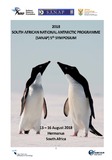- ALSA Home
- →
- Documents
- →
- Research Events
- →
- View Item
JavaScript is disabled for your browser. Some features of this site may not work without it.
| dc.contributor.author | Mosotho, M.G. | |
| dc.contributor.author | Kruger, H. | |
| dc.contributor.author | Strauss, R.D. | |
| dc.contributor.author | Kosch, M.J. | |
| dc.coverage.spatial | Commercial Airline Altitudes | |
| dc.date.accessioned | 2021-03-05T15:52:50Z | |
| dc.date.available | 2021-03-05T15:52:50Z | |
| dc.date.created | 18-Aug | |
| dc.date.issued | 18-Aug | |
| dc.identifier.uri | http://hdl.handle.net/123456789/28439 | |
| dc.description.abstract | Scientists have been assessing the exposure of crewmembers and passengers of commercial airlines to ionizing radiation ever since it was identified as a health risk in the early 1960s. Progress has been made over the years in measuring and monitoring radiation at flight altitudes. The interaction of ionizing radiation with cellular DNA might lead to harmful effects such as cancer. To monitor and measure the radiation exposure of commercial airline crewmembers and passengers, a very small and lightweight active dosimeter known as HARM, an acronym for High Altitude Radiation Monitor, was developed and built. This instrument uses a silicon semiconductor sensor capable of measuring neutral and charged particles during a flight. Measurements obtained during a flight have been shown to exceed the limits of ground level workplaces and consequently, radiation exposure could be harmful to crewmembers and passengers. Therefore, monitoring changing radiation parameters in space and time is essential. In this presentation, I will talk about HARM observations and discuss current approaches to radiation risk estimation used by radiation agencies. - Abstract as displayed in the - Abstract booklet. The presentation on the day may differ from the - Abstract. | en_ZA |
| dc.description.sponsorship | Sponsored by the the Department of Science and Innovation(DSI) through National Research Foundation (NRF) - South Africa | en_ZA |
| dc.description.statementofresponsibility | Antarctic Legacy of South Africa | en_ZA |
| dc.format | en_ZA | |
| dc.language | English | en_ZA |
| dc.language.iso | en_ZA | en_ZA |
| dc.publisher | South African National Antarctic Programme (SANAP. | en_ZA |
| dc.relation | SANAP Symposium 2018 | en_ZA |
| dc.rights | Copyright | en_ZA |
| dc.rights | Copyright | en_ZA |
| dc.subject | Research | en_ZA |
| dc.subject | Science | en_ZA |
| dc.subject | Meetings | en_ZA |
| dc.subject | Symposium | en_ZA |
| dc.subject | SANAP Symposium 2018 | en_ZA |
| dc.subject | Ionizing Radiation | en_ZA |
| dc.subject | Commercial Airlines | en_ZA |
| dc.subject | Radiation | en_ZA |
| dc.subject | Flights | en_ZA |
| dc.subject | Radiation Exposure | en_ZA |
| dc.subject | Dosimeter | en_ZA |
| dc.subject | HARM | en_ZA |
| dc.subject | Space Science | en_ZA |
| dc.subject | Earth Systems | en_ZA |
| dc.title | Dosimetry at commercial airline altitudes | en_ZA |
| dc.type | Abstracts | en_ZA |
| dc.rights.holder | Antarctic Legacy of South Africa | en_ZA |
| dc.rights.holder | Mosotho, M.G. | en_ZA |
| dc.rights.holder | Kruger, H. | en_ZA |
| dc.rights.holder | Strauss, R.D. | en_ZA |
| dc.rights.holder | Kosch, M.J. | en_ZA |
| iso19115.mdconstraints.uselimitation | This item and the content of this website are subject to copyright protection. Reproduction of the content, or any part of it, other than for research, academic or non-commercial use is prohibited without prior consent from the copyright holder. | en_ZA |
| iso19115.mddistributor.distributorcontact | South African National Antarctic Programme -SANAP. | en_ZA |
| iso19115.mdformat.name | en_ZA | |
| iso19115.mdidentification.deliverypoint | Antarctic Legacy of South Africa, Faculty of Science, Private Bag X1, Matieland. Stellenbosch. South Africa. | en_ZA |
| iso19115.mdidentification.electronicmailaddress | antarcticlegacy@sun.ac.za | en_ZA |
| iso19115.mdidentification.organizationname | North-West University | en_ZA |
| iso19115.mdidentification.organizationname | South African National Space Agency | en_ZA |
Files in this item
This item appears in the following Collection(s)
-
Research Events [502]
Material directly related to official scientific and research events

